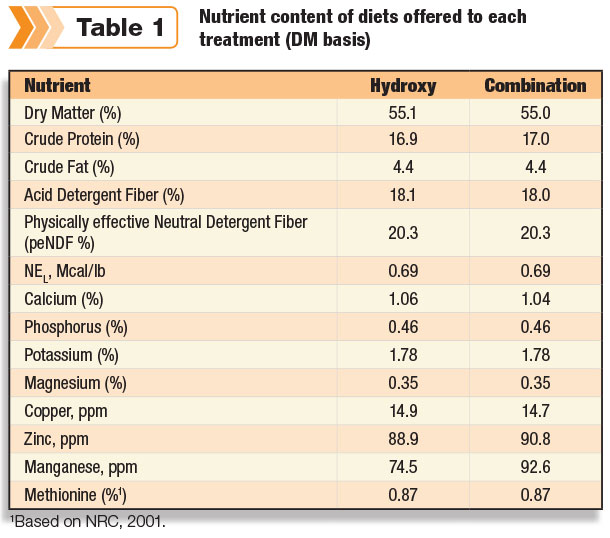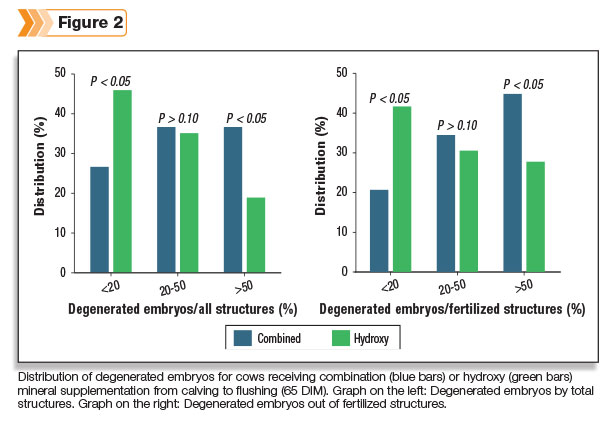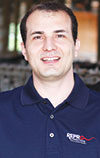Trace minerals are critical for adequate immune function and metabolism in dairy cattle. Research shows that trace minerals have antioxidant functions and may help reduce the level of oxidative stress postpartum as well as improve immune response to vaccines.
Oxidative stress refers to the inability of the body to counteract or detoxify itself of the harmful effects of free radicals through neutralization by antioxidants.
This imbalanced state is often increased around calving time due to drastic changes in metabolism; thus, anti-oxidative nutritional strategies may help reduce metabolic problems and improve postpartum health.
Hydroxy trace minerals have covalent bonds linking trace minerals such as copper, zinc and manganese to a hydroxy (oxygen-hydrogen) group and are described to be more bioavailable than sulfate trace minerals and comparable or greater in bioavailability to organic trace minerals.
Hydroxy minerals are less soluble at the pH levels typically found in the rumen. They become soluble in the lower pH environment of the abomasum, allowing for their absorption in the cow’s intestinal tract.
Thus, some of the benefits of supplementing hydroxy minerals are likely related to their capacity to bypass the rumen, therefore improving their ability to increase the delivery of trace metals to the cow’s bloodstream.
Of importance is that greater availability of trace minerals such as zinc, manganese and copper have been previously associated with improved fertility. Particularly, zinc appears to have positive effects on oocyte and embryo quality.
Field study findings
In this study (Figure 1), our objective was to test whether or not the mineral source fed after calving from zero to 70 days in milk (DIM) improves postpartum uterine health and embryo quality from superovulated cows.
 Trace mineral sources met the trace mineral requirements as noted by the herd nutritionist. In addition, all diets had recommended levels of methionine.
Trace mineral sources met the trace mineral requirements as noted by the herd nutritionist. In addition, all diets had recommended levels of methionine.
Cows were then randomized to receive two types of mineral supplementation at calving, as follows:
- Combination: Sulfate sources of manganese, hydroxyl sources of copper and 75 percent zinc sulfate/25 percent organic zinc
- Hydroxy: Hydroxyl sources of copper, zinc and manganese
A total of 100 mature Holstein cows (multiparous only) were enrolled at calving, as follows (see Figure 1).
After calving, cows were located in two identical pens on the same side of a freestall facility. Superovulation was performed using a modified double-Ovsynch protocol and a single-follicle-stimulating hormone (FSH) batch (400 mg per cow).
Cows were flushed through the standard, non-surgical method to evaluate embryo production and quality according to International Embryo Transfer Service (IETS) guidelines by the same treated-blind lab technician.
To avoid sire variation, cows were artificially inseminated by the same A.I. technician utilizing regular (non-sexed) semen from a single sire/single ejaculate donated by Select Sires.
 Diets fed to close-up cows were typical of that fed in the Central Valley of California. Nutrient content of diets fed to both treatment groups were similar except for manganese levels. Reason for this difference is unknown as both mineral sources were formulated to meet identical nutrient needs of both groups.
Diets fed to close-up cows were typical of that fed in the Central Valley of California. Nutrient content of diets fed to both treatment groups were similar except for manganese levels. Reason for this difference is unknown as both mineral sources were formulated to meet identical nutrient needs of both groups.
There were no differences between the two treatments in terms of superovulation results measured as number of corpus luteum (CL) produced after FSH treatments, average number of recovered structures and average number and percentage of transferable and freezable embryos.
Interestingly, hydroxy mineral supplementation reduced the proportion of degenerated embryos both in relation to all structures or fertilized structures (Table 2).
 Further exploratory analysis confirmed that supplementation with hydroxy minerals increased the proportion of cows having less than 20 percent of degenerated embryos. As a result, a greater proportion of cows that received the combination diet were more likely to produce more than 50 percent of the degenerated embryos (Figure 2).
Further exploratory analysis confirmed that supplementation with hydroxy minerals increased the proportion of cows having less than 20 percent of degenerated embryos. As a result, a greater proportion of cows that received the combination diet were more likely to produce more than 50 percent of the degenerated embryos (Figure 2).
 These results indicate that feeding the hydroxy mineral significantly reduced the proportion of degenerated embryos as well as proportion of cows yielding more than 80 percent of good-quality embryos.
These results indicate that feeding the hydroxy mineral significantly reduced the proportion of degenerated embryos as well as proportion of cows yielding more than 80 percent of good-quality embryos.
These findings are in agreement with some studies utilizing the in vitro embryo model. For example, previous reports have shown that supplemental zinc in the IVF media can improve early embryo development and quality by reducing the amount of DNA damage and death in the specific cells that surround and nourish it.
In addition, it has been demonstrated that both zinc and manganese increased the ability of these cells to disarm free radicals. This appears to have practical implications since cows in the postpartum period have problems with oxidative stress that can lower embryo quality.
This could potentially mean a greater ability to provide antioxidant protection to embryos growing in less-than-ideal oxidative stress environments postpartum.
Zinc also plays a role in the expansion and fertilization of cells surrounding the embryo. More importantly, those supplemented with zinc showed a greater proportion of embryos developing to blastocyst stage, a critical point at which the embryo will have a greater chance of implementation.
In conclusion, these results support the hypothesis that feeding hydroxy minerals can improve embryo quality in postpartum dairy cows – with a possible positive impact on conception results that needs to be explored in future field studies. PD
Alex Souza is a veterinarian and Ph.D. with 17 years of experience in cattle management and reproductive biotechnologies.
References omitted due to space but are available upon request. Click here to email an editor.

-
Alex Souza
- Research and Development
- Ceva Animal Health
- Email Alex Souza









